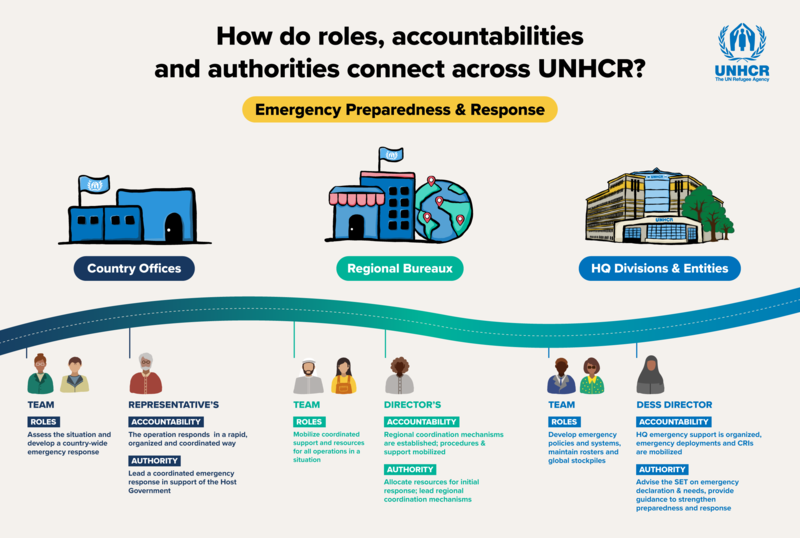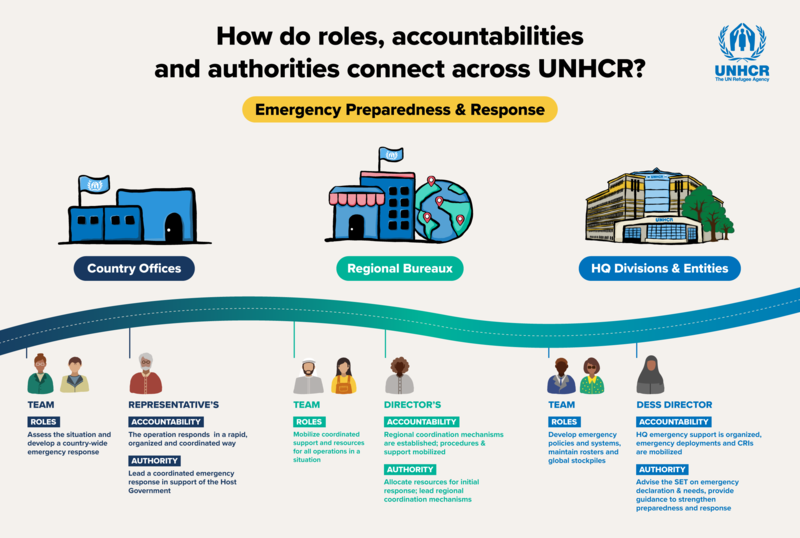Overview
The overriding priority in any humanitarian response is to save lives and minimize serious harm, through meeting the most urgent humanitarian needs. UNHCR’s Policy on Emergency Preparedness and Response sets out UNHCR’s internal mechanisms for emergency preparedness – such as risk management and contingency planning – and response – including when and how an emergency is declared, coordination arrangements and support mechanisms.
Relevance for emergency operations
The Policy establishes the framework for how UNHCR prepares for and responds to emergencies. It applies to all UNHCR staff members and affiliate workforce in the field and at headquarters who are engaged in leading, managing, delivering, overseeing and/or supporting any aspect of emergency preparedness and response. Compliance with the policy is mandatory.
Main guidance
UNHCR declares an emergency when two criteria are met. Firstly, there is a humanitarian crisis or disaster which either has caused or threatens to cause new forced displacement, loss of life or other serious harm, or which significantly affects the rights or well-being of displaced and stateless persons, unless immediate action is taken. Secondly, the humanitarian crisis must demand exceptional measures because current government and UNHCR capacities are inadequate for a predictable and effective response. The declaration of an emergency level is based on a country operation's analysis of the situation, as well as its existing preparedness and response capacity.
Key Principles: The humanitarian principles of humanity, impartiality, independence and neutrality are central to UNHCR’s emergency preparedness and response. These are complemented by a set of additional principles including the centrality of protection, state responsibility and humanitarian complementarity, acting on a ‘do no harm’ and ‘no regrets basis’, protection from sexual exploitation and abuse and sexual harassment, duty of care, diversifying partnerships, solutions and link to development, and environmental sustainability.
Emergency preparedness: Proactive preparedness and early engagement are fundamental for a timely and effective response.
The key to proactive preparedness is strong risk management. All country operations should undertake risk analysis for new or escalated emergencies at least once a year as part of the Annual Risk Review, in line with the Policy for Enterprise Risk Management in UNHCR (access for UNHCR staff only). Operations then determine a ranking of high, medium or low risk for each identified emergency scenario, based on its likelihood and potential impact. The identified emergency risks should be recorded in the Operational Risk Register and continuously monitored.
If there is a high risk of an emergency, country operations must develop a scenario-based contingency plan in collaboration with government counterparts and other partners. The level of engagement of Governments and partners may vary in different operations and contexts. A contingency plan should articulate the response strategy, including required budget, workforce, coordination structures, and thresholds for triggering activation. As part of the contingency planning process, operations should also identify key preparedness measures that would need to be implemented to enable the planned emergency response. These measures and actions can include establishing frame agreements, identifying potential financial service providers, pre-selecting a pool of potential partners through a Call for Expression of Interest, and assessing the potential partners’ capacity. The recommended list of preparedness actions is constantly updated by Division of Emergency, Security and Supply (DESS) and is available on the DESS Emergency Preparedness and Response Portal (accessible to UNHCR staff only).
In addition to UNHCR’s own emergency preparedness, operations contribute to inter-agency preparedness. In refugee situations, UNHCR country operations lead inter-agency contingency planning. In all other situations of forced displacement, including internal displacement caused by conflict and natural hazards, and mixed situations, operations should actively participate in the RC/HC-led processes and lead preparedness for the relevant sectors/clusters.
For more information on emergency preparedness, including risk analysis, contingency planning and inter-agency processes, please refer to the UNHCR Guidance on Emergency Preparedness (UNHCR/OG/2023/02) (accessible to UNHCR staff only).
Natural hazards and climate change: The drivers and impacts of displacement are becoming increasingly complex and intertwined, especially in the context of climate change. The Policy strengthens the predictability and effectiveness of UNHCR’s engagement in emergencies triggered by natural hazards and climate change. In particular, in such situations, it emphasizes the importance of strategic thinking and decision-making in the preparedness phase. The level of involvement in natural hazard-induced crises should be decided based on UNHCR’s presence and operational capacity in the country, and expertise compared to other humanitarian actors.
Declaring an emergency: UNHCR may declare one of three emergency levels, depending on the magnitude, complexity and consequences of the humanitarian crisis compared to the existing capacity of the operation(s) and bureau(x) concerned. All emergency declarations expire automatically after 6 months. For a Level 1 emergency, there is no possibility of extension. However, in exceptional circumstances, Level 2 and Level 3 emergencies can be extended for a further three months, up to a maximum of 9 months. See the Comparative Table of UNHCR Emergency Levels for more details.
A single country may have more than one emergency declaration at any given time, if humanitarian crises are geographically or contextually distinct from one another. For example, there may be a refugee influx and an internal displacement situation in different parts of the same country, with both requiring an emergency declaration. Similarly, a humanitarian crisis may require an emergency to be declared in several countries, especially when cross-border displacement is expected.
A UNHCR emergency declaration is distinct from an IASC Humanitarian System-Wide Scale-Up Activation. When a Scale-Up is issued, UNHCR must fulfils its commitments as an IASC member and upscale its own coordination and operational response. This may include declaring or extending an internal UNHCR emergency, if deemed appropriate and in line with UNHCR’s own Policy.
Coordination: The Policy clarifies country-level coordination mechanisms for refugee and IDP emergencies, in line with the Global Compact on Refugees and Refugee Coordination Model, the Policy on UNHCR’s Engagement in Situations of Internal Displacement respectively, and the cluster system. It also clarifies country-level coordination arrangements for mixed situations.
Simplified procedures: The Policy introduces simplified procedures in areas such as supply, partnership agreements and access to financial and human resources – including deployments and staffing. These emergency procedures are applicable to all emergency levels, for the entire duration of an emergency declaration, to expedite the delivery of life-saving protection and assistance.
Once an emergency has been declared, regardless of the emergency level, country operations can also request additional financial resources from the Emergency-reserved Budget. The regional bureau Director has the authority to allocate up to USD 5 million per country. For requests of up to USD 10 million per country, the authority sits with the Assistant High Commissioner for Operations. The maximum amount of allocations is USD 10 million per country, per declared emergency. The allocations are cumulative throughout the emergency declaration, including any extension and change of level.
Additional support instruments: For Level 2 and Level 3 emergencies, additional support is provided by the regional bureaux and Headquarters. Once a Level 2 or Level 3 emergency is declared, a Senior Level Working Group (SLWG) is convened within two weeks, to ensure that the necessary organizational capacities are in place to support a timely and effective response. Within four weeks, a Joint Senior Level Mission (JSLM) takes place. For Level 3 emergencies, a Real-Time Review is conducted three months after the emergency declaration.
Roles and responsibilities: The Policy sets out the roles and responsibilities in an emergency at country, regional and global level. The Policy empowers and requires country operations to take the lead in emergency preparedness and response, with the support of regional bureaux and HQ divisions and entities.

Post emergency phase
The expiry of an emergency declaration does not necessarily imply that the crisis has come to an end. Rather, it means that preparedness actions are in place or that the operational response has been scaled up and reasonably stabilized, to the extent that additional resources and special procedures are no longer required. It is important to ensure a smooth transition into a regular operational response once the emergency declaration expires. Therefore, from the beginning of an emergency, country operation(s) should begin planning for the post-emergency period.
At the end of the emergency declaration, to ensure continuity of coordination and/or response, country operation(s), regional bureau(x) and DESS, in collaboration with key HQ divisions, review, inter alia: relevant protection and operational strategies, frameworks and leadership arrangements; operational footprint, structure and security. This includes a careful review of offices and staffing arrangements in line with allocated financial resources and projected funding levels.
Policies and guidelines
Learning and field practices
Main contacts
For guidance and advice on the Policy, or on emergency preparedness and response more generally, please contact [email protected]
In this section:
Let us know what you think of the new site and help us improve your user experience….
Let us know what you think of the new site and help us improve your user experience….


